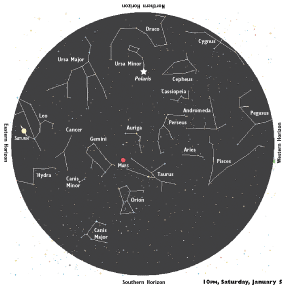Winter’s Cold, Dark Skies
As the season’s chill sets in, warm up with the promise of longer days
Although winter has only begun, Saturday marks a turning point in the seasons with the year’s latest daybreak at 7:27. Granted, winter solstice two weeks ago marked the year’s shortest day, but Earth’s elliptical orbit around the sun separates the earliest sunset and the latest sunrise by almost an entire month. Now, bit by bit, our days grow longer in morning and evening.
Another celestial milestone has come and passed, as Earth reached perihelion, its closest point to the sun, on January 2. A mere 91 million miles separated us from old sol, compared with 95 million miles at aphelion in early July. The difference in distance, however, has little effect on the temperature or the seasons. Instead, the seasons are a result of Earth’s 231⁄2-degree tilted axis. In Earth’s orbit, the hemisphere facing the sun receives more light, which reaches the surface more directly and with less lost in the atmosphere. All this makes the days warmer and longer.
Thursday night/Friday morning brings the year’s coldest meteor shower, the Quadrantids, which peak around 1:40am. With the waning moon rising after 4am, the Quads could deliver up to 100 meteors an hour — for those hardy enough to brave the cold to see them.
Mars shines in the east-northeast at sunset, and although fading since last month’s opposition, it’s still as bright as any star. By midnight it is high overhead, and with sunrise it sets in the northwest.
Saturn rises after 9pm amid the stars of Leo the lion and is high in the east with dawn.
Venus, rises in the east-southeast after 4am. Friday it forms a triangle with the crescent moon and fiery Antares.
Tidelog®
Illustration: © Copyright 1925 M.C. Escher/Cordon Art-Baarn-Holland; Graphics: © Copyright 2007 Pacific Publishers. Reprinted by permission from the Tidelog graphic almanac. Bound copies of the annual Tidelog for Chesapeake Bay are $14.95 ppd. from Pacific Publishers, Box 480, Bolinas, CA 94924. Phone 415-868-2909. Weather affects tides. This information is believed to be reliable but no guarantee of accuracy is made by Bay Weekly or Pacific Publishers. The actual layout of Tidelog differs from that used in Bay Weekly. Tidelog graphics are repositioned to reflect Bay Weekly’s distribution cycle.Tides are based on National Oceanic and Atmospheric Administration and are positioned to coincide with high and low tides of Tidelog.